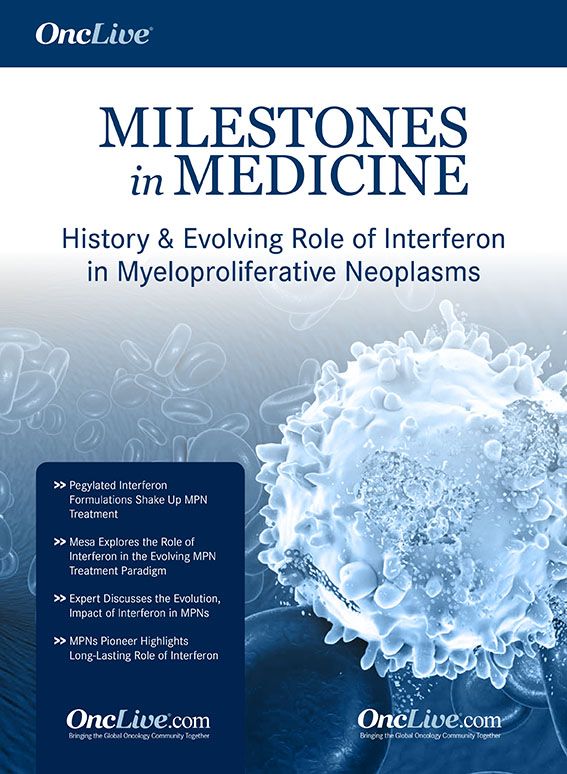MPNs Pioneer Highlights Long-Lasting Role of Interferon
Richard T. Silver, MD, discusses the history of interferon and shares insight on why the drug still holds its place in the treatment of patients with MPNs.
Richard T. Silver, MD

Richard T. Silver, MD
Despite the rise of newer, effective therapies since the inception of interferon 30 years ago, there is still a biologic basis for its use in the treatment of patients with myeloproliferative neoplasms (MPNs), according to Richard T. Silver, MD.
In polycythemia vera (PV), for example, patients typically develop symptomatic iron deficiency and thrombotic events. Interferon, which inhibits PDGF, TGFβ, and other critical pathways, reduces the risk of these events, explained Silver, who is a professor of medicine at Weill Cornell Medical College/NewYork-Presbyterian.
“There is evidence that interferon will also reduce the cellularity of the bone marrow, which is responsible for producing the number of white and red blood cells and platelets that we see in PV,” added Silver.
The phase III PROUD-PV study, which compared ropeginterferon alfa-2b with hydroxyurea in patients with PV, further established the role for interferon in the treatment paradigm. Results showed that ropeginterferon alfa-2b was noninferior to hydroxyurea, with a 12-month complete hematologic remission rate of 43.1% versus 45.6%, respectively. The need for phlebotomy for patients treated with interferon dropped from 86% to 6%, and 37% of patients achieved a JAK2 molecular response with the therapy.
OncLive: How has interferon been used traditionally for the treatment of patients with MPNs?
In an interview with OncLive, Silver provided the history of interferon and shared insight on why the drug still holds its place in the treatment of patients with MPNs.Silver: The use of interferon was first reported by me in 1988. Since that time, we have developed extensive experience using it at Weill Cornell Medicine. We use it preferentially to any other agent because there is a biologic basis for its use. In comparison with the most commonly used drug—hydroxyurea, which is a nonspecific cell poison—there is a biologic basis for its use. It interferes with cell development and marrow fibrosis by interfering with PDGF and VEGF; it also affects JAK signaling. As I said, interferon is a drug for which there is a meaningful use—it is not a nonspecific myelosuppressive.
In our clinic, we don't believe in the "watch and wait" approach that is recommended by some [physicians] because it develops iron deficiency in patients; this has been getting a lot more attention now both in men and women. Most women become iron deficient because of menstruation. Phlebotomy will obviously add to that in men, irrespective of the fact that they don't menstruate. The average patient with PV we see requires about 8 phlebotomies. The maintenance thereof should not be phlebotomy only, even in so-called good-risk patients. This is because the phlebotomy rate is higher in those patients than in the normal population and because it doesn't suppress disease. It is sort of like treating a diabetic and letting their blood sugar rise while the patient has blood in the urine. You can't just treat their symptoms without giving them insulin.
Could you expand on the use of interferon in today’s landscape?
We believe that there are 2 reasons for using interferon. First, there is a biologic basis for its use, and secondly, it avoids the development of iron deficiency. In addition, there is evidence that interferon can reduce thrombotic risk, which is significant for patients who are only treated with phlebotomy. We also have evidence from more than 300 patients with PV that the fibrosis we see in this disease will have a delayed onset of disease when they are treated with interferon; this is because interferon affects PDGF and TGFβ, as well as other cytokines that are responsible for the development of myelofibrosis. This is very exciting, and it is new information; it has never been shown in any population of patients. We presented a poster on this at the 2018 ASH Annual Meeting.We believe that in the long-term—not the short-term use—that hydroxyurea can cause leukemia in about 8% to 10% of patients. In a 15-year span, this number increases to about 15%. A patient can no longer use the drug if he/she develops secondary leukemia. There has never been a controlled study evaluating hydroxyurea over the long-term compared with phlebotomy because most patients cannot stay on phlebotomy.
Interferon will significantly reduce the risk of developing secondary leukemia—this is very important. I might say that the reason there has not been a controlled trial for this is because of 1 trial conducted by French [researchers], which compared the use of hydroxyurea with pipobroman. Thank goodness this drug is not available in the United States because it is very leukemogenic in patients with PV, even more so than hydroxyurea. There is evidence that interferon will also reduce the cellularity of the bone marrow, which is responsible for producing the number of white blood cells, red blood cells, and platelets that we see in PV. We reported on that a couple of years ago as well.
Where does ruxolitinib (Jakafi) play into this?
We also have evidence that interferon will reduce JAK2, the genetic abnormality that characterizes PV. We are not quite sure what that means, because we can see marrow reduction in patients that don't have significant decreases in JAK2. Anyway, there is evidence that interferon will certainly affect significant parameters of the disease. Lastly, the data from an Austrian group suggest that in a controlled trial, interferon can lead to significant differences in remission rates compared with hydroxyurea [at 1 year]. I would imagine this study will be published relatively soon. Those are the reasons that we believe interferon should have preference over other options in patients with PV. We think ruxolitinib is a useful drug. As you know, it has been FDA approved for its efficacy in intermediate- and high-risk disease. Many doctors prescribe it for patients with earlier-stage myelofibrosis if a patient is symptomatic. Ruxolitinib is very helpful in these patients, but I don't believe it definitively changes the disease from the standpoint of bone marrow remission. It will make the spleen smaller in a significant number of patients with myelofibrosis at about 30% to 40%. At the end of 5 years, more than 60% are off this drug.
Has progress being made in stratifying patients into more precise subgroups?
In my view, ruxolitinib re-treats constitutional symptoms such as fatigue, weight loss, and bone pain. I believe it should be used in combination with interferon for the treatment of PV. There are studies from Weill Cornell Medicine about the early use of interferon for biologic abnormalities and the use of ruxolitinib for symptomatic improvement. There is also, perhaps, biologic synergy between these 2 agents. You are referring to risk factor analysis, and there have been several schemas to establish risk categories for patients with MPNs, particularly myelofibrosis and PV; these have all been based on retrospective data. They have never been looked at prospectively; therefore, they should be viewed with some degree of caution. Nevertheless, they are helpful clinically because they allow the comparison of patients in different investigational groups. It is important to note that none of these studies have included bone marrow findings, and those are important risk factors. However, because the data are retrospective, they have not been included in these data categorizations.
Most recently, these schemas have been amplified in their accuracy by considering their molecular abnormalities that particularly categorize myelofibrosis. When patients have genetic abnormalities such as ASXL1, EGH2, or others, those are associated with poor prognosis. Therefore, if one sees those molecular abnormalities in association with other poor prognostic signs, they should be considered for bone marrow transplantation. We know that in advanced disease, interferon is not effective—particularly when the bone marrow is fibrotic or if the spleen is very large. Now, we know that if there are these additional molecular markers, patients won't respond well either. I would alert clinicians to use these scoring systems despite the fact there's some limitations.
Gisslinger H, Klade C, Georgiev P, et al. Final results from proud-pv a randomized controlled phase 3 trial comparing ropeginterferon alfa-2b to hydroxyurea in polycythemia vera patients. Blood. 2016;128(22):475. bloodjournal.org/content/128/22/475?sso-checked=true.




